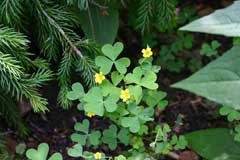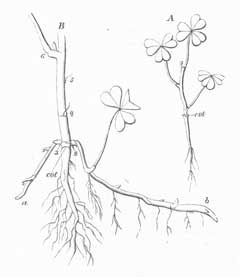 |
|
http://commons.wikimedia.org/wiki/User:SB_Johnny |
 |
|
Translate this page:
Summary
Bloom Color: Yellow. Main Bloom Time: Early fall, Late summer, Mid summer, Mid fall. Form: Upright or erect.
Physical Characteristics

 Oxalis stricta is a ANNUAL growing to 0.3 m (1ft) at a fast rate. It is in flower from July to October. The species is hermaphrodite (has both male and female organs) and is pollinated by Insects.
Oxalis stricta is a ANNUAL growing to 0.3 m (1ft) at a fast rate. It is in flower from July to October. The species is hermaphrodite (has both male and female organs) and is pollinated by Insects.
Suitable for: light (sandy) and medium (loamy) soils, prefers well-drained soil and can grow in nutritionally poor soil. Suitable pH: mildly acid, neutral and basic (mildly alkaline) soils. It cannot grow in the shade. It prefers dry or moist soil.
UK Hardiness Map
US Hardiness Map
Synonyms
O. dillenii.
Plant Habitats
Cultivated Beds; South Wall. In. West Wall. In.
Edible Uses
Edible Parts: Flowers Leaves Root Seedpod
Edible Uses: Drink
Leaves - raw or cooked[46, 61, 105]. A nice acid flavour[159], the leaves can also be chewed as a thirst quencher[183]. Use in moderation, see notes at top of sheet, Flowers - raw[105, 161, 183]. Added to salads. Young seedpods - raw[183]. Root[105, 161, 183]. No further details. A lemon-flavoured drink is made from the leaves[159].
References More on Edible Uses
Medicinal Uses
Plants For A Future can not take any responsibility for any adverse effects from the use of plants. Always seek advice from a professional before using a plant medicinally.
Febrifuge Poultice Stomachic
An infusion of the plant has been used in the treatment of fevers, stomach cramps and nausea[257]. A poultice of the plant has been used to treat swellings[257].
References More on Medicinal Uses
The Bookshop: Edible Plant Books
Our Latest books on Perennial Plants For Food Forests and Permaculture Gardens in paperback or digital formats.

Edible Tropical Plants
Food Forest Plants for Hotter Conditions: 250+ Plants For Tropical Food Forests & Permaculture Gardens.
More

Edible Temperate Plants
Plants for Your Food Forest: 500 Plants for Temperate Food Forests & Permaculture Gardens.
More

More Books
PFAF have eight books available in paperback and digital formats. Browse the shop for more information.
Shop Now
Other Uses
Dye
A yellow to orange dye can be obtained by boiling up the whole plant[257].
Special Uses
References More on Other Uses
Cultivation details
Easily grown in a sandy soil in a warm dry position[1]. Very closely related to O. corniculata, and seen as no more than a variety of that species by some botanists[266]. This variety differs from O. corniculata by stems erect, not rooting at nodes; branched or not[266]. Special Features:
North American native, Invasive, Naturalizing, Inconspicuous flowers or blooms.
References Carbon Farming Information and Carbon Sequestration Information
Temperature Converter
Type a value in the Celsius field to convert the value to Fahrenheit:
Fahrenheit:
The PFAF Bookshop
Plants For A Future have a number of books available in paperback and digital form. Book titles include Edible Plants, Edible Perennials, Edible Trees,Edible Shrubs, Woodland Gardening, and Temperate Food Forest Plants. Our new book is Food Forest Plants For Hotter Conditions (Tropical and Sub-Tropical).
Shop Now
Plant Propagation
Seed - best sown as soon as it is ripe in a cold frame. When they are large enough to handle, prick the seedlings out into individual pots and plant them out in the summer. If you have enough seed it can be sown in situ during the spring.
Other Names
If available other names are mentioned here
Native Range
TEMPERATE ASIA: China (Guangxi Zhuangzu Zizhiqu, Hebei Sheng, Henan Sheng, Hubei Sheng, Jiangxi Sheng, Jilin Sheng, Liaoning Sheng, Shanxi Sheng, Zhejiang Sheng), Korea, Japan (Hokkaidô, Honshu) NORTHERN AMERICA: United States (Connecticut, Indiana, Maine, Massachusetts, New Hampshire, New Jersey, New York, Ohio, Pennsylvania, Rhode Island, Vermont, West Virginia, Iowa, Kansas, Minnesota, Missouri, North Dakota, South Dakota, Illinois, Oklahoma, Alabama, Arkansas, Delaware, Georgia, Kentucky, Maryland, Mississippi, North Carolina, South Carolina, Tennessee, Virginia)
Weed Potential
Right plant wrong place. We are currently updating this section.
Please note that a plant may be invasive in one area but may not in your area so it's worth checking.
Conservation Status
IUCN Red List of Threatened Plants Status :

Growth: S = slow M = medium F = fast. Soil: L = light (sandy) M = medium H = heavy (clay). pH: A = acid N = neutral B = basic (alkaline). Shade: F = full shade S = semi-shade N = no shade. Moisture: D = dry M = Moist We = wet Wa = water.
Now available:
Food Forest Plants for Mediterranean Conditions
350+ Perennial Plants For Mediterranean and Drier Food Forests and Permaculture Gardens.
[Paperback and eBook]
This is the third in Plants For A Future's series of plant guides for food forests tailored to
specific climate zones. Following volumes on temperate and tropical ecosystems, this book focuses
on species suited to Mediterranean conditions—regions with hot, dry summers and cool, wet winters,
often facing the added challenge of climate change.
Read More
Expert comment
Author
L.
Botanical References
43274
Links / References
For a list of references used on this page please go here
Readers comment